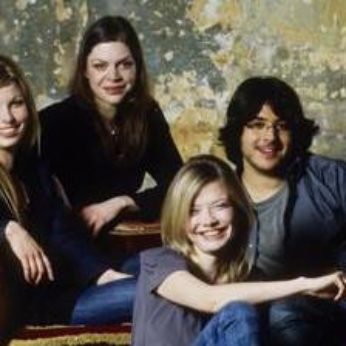Composer: Wolfgang Amadeus Mozart (b. 1756 - d. 1791)
Performance date: 04/07/2012
Venue: St. Brendan’s Church
Composition Year: 1783
Duration: 00:30:18
Recording Engineer: Anton Timoney, RTÉ lyric fm
Instrumentation: 2vn, va, vc
Instrumentation Category:String Quartet
Artists:
Chiaroscuro Quartet (Alina Ibragimova, Pablo Hernán Benedí [violins], Emilie Hörnlund [viola], Claire Thirion [cello]) -
[quartet]

This dark-coloured, multi-faceted
quartet is the second of the six quartets that Mozart dedicated to
Haydn, famously describing them as his children and the fruit of
long and laborious efforts. Mozart had never said this about any
of his other works. We cannot hear the effort involved but the
intensity and concentration of the process of composition can be seen
on the manuscript scores, nowhere else does Mozart make so many
corrections, strewn above crossed-out tempi and dynamic markings.
These quartets that Mozart worked on so
hard over a three year period were his response to Haydn’s recent
publication of his so-called Russian Quartets (Op.33). The
development of the string quartet was still in its infancy so the two
friends were making up the rules as they went along, with Mozart
building on the foundations laid by the older composer. The quartets
he dedicated to Haydn were not commissions and were almost certainly
composed for his own artistic fulfilment and to gain the respect of
Haydn, but economic necessity may have played a part in dragging out
the composition process. This was a time when quartets were almost
entirely for domestic performance by amateur players. Mozart would
regularly host chamber music evenings at his house and his friends,
including Haydn and other Viennese composers like Dittersdorf, would
join him to play their quartets – Haydn would play first fiddle and
Mozart the viola, an event a musical time-traveller would dearly like
to witness.
The D minor quartet is the second in
the sequence and Constanze used to say that Mozart wrote it while she
was in labour with their first child. She even claimed her cries were
scored in the great outburst in the second movement. There is a
school of thought that considers all Mozart’s D minor works speak of
darkness and tragedy and that the tragic demeanour of the music
reflected some terrible event in the composer’s life, which is hardly
the case with this work. Much more likely an explanation for the
presence of the minor key was the convention that one work in a set
of six should be in the appropriate minor key and Mozart seizes the
opportunity to create a wonderful palette of colours. Played with gut
strings the melodic contours, the descending bass and the expressive
language even recall the Baroque era. After the exposition repeat
there is a short but intense development full of rich, dark colours.
Mozart asks for a repeat of the development and recapitulation, a
request that modern performance tends to ignore. The movement ends
firmly upbeat despite being in the minor.
The Andante is a sombre movement with
its quietly elegiac theme and its curious hesitancies and sudden
outcries. There is a short central section that briefly lightens the
mood with its song. The minor key is held relentlessly in the severe
and many-voiced Minuet. In dazzling contrast, the Trio provides a ray
of sunshine, the first violin playing a popular folk melody over a
pizzicato serenade-like accompaniment. The Finale is a set of four
variations and coda on a plaintive theme in Siciliano rhythm. Early
on we hear a rhythmic motif in triplets on a single note, which is to
reappear as a leitmotiv in the third variation and more dramatically
in the coda. The first variation sees the first violin part richly
ornamented. The second has great sport with misplacing the accents,
upsetting the rhythm to great effect. The third variation is given to
the viola while the leitmotiv reasserts itself in the upper voices.
The transformation of the theme in the final variation borders on the
magical, revealing a transient beauty that is gradually swept away by
the return of the leitmotiv in the coda, where it rises to a
passionate fortissimo before leading the way to the closure.
Copyright © 2025 West Cork Music. All rights reserved.
Designed and developed by Matrix Internet